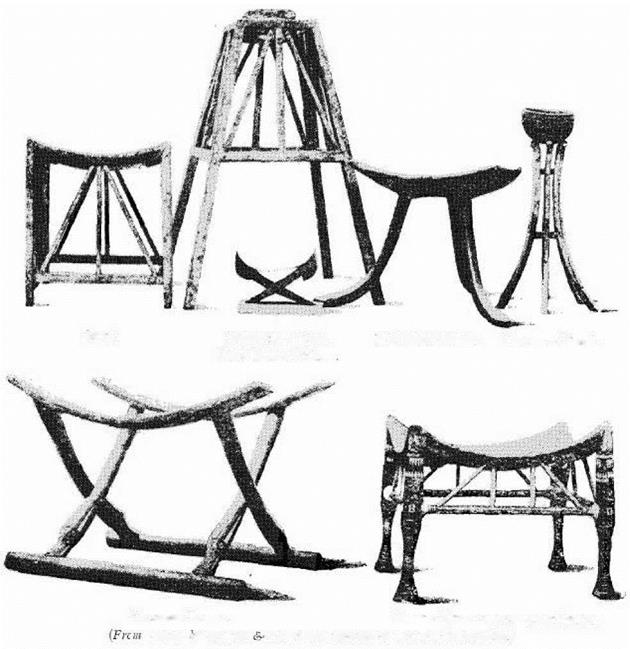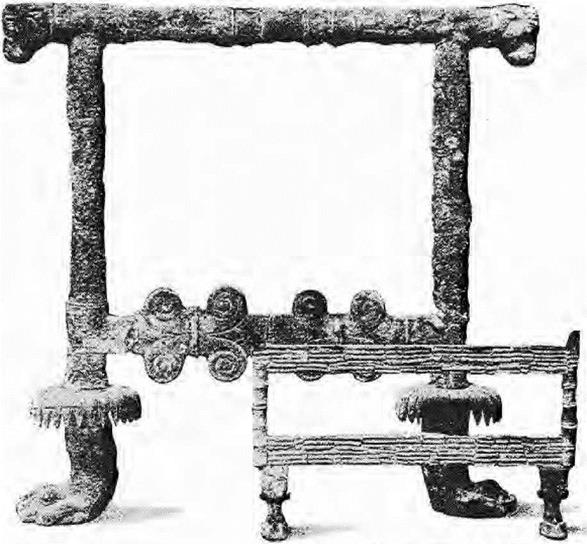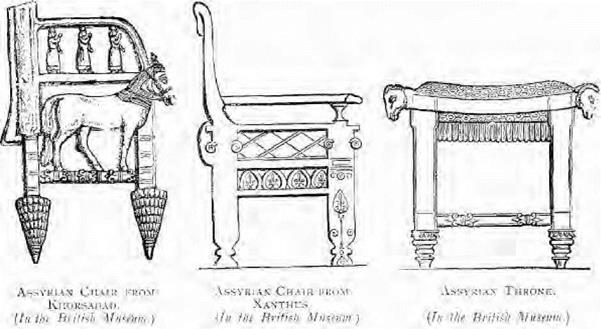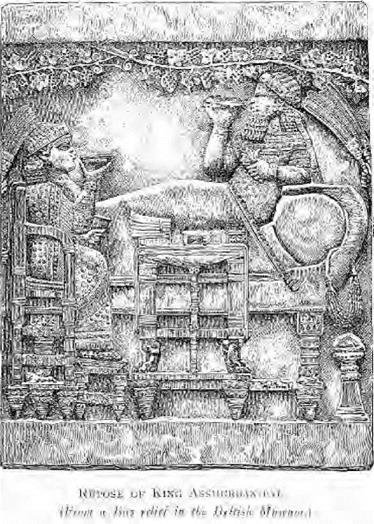Biblical References: Solomon’s House and Temple—Palace of Ahashuerus, Assyrian Furniture: Nimrod’s Palace—Mr, George Smith quoted, Egyptian Furniture: Specimens in the British Museum—the Workman’s Stool—various articles of Domestic Furniture—Dr, Birch quoted, Greek Furniture: The Bas Reliefs in the British Museum—the Chest of Cypselus—Laws and Customs of the Greeks—House of Alcibiades—Plutarch quoted, Roman Furniture: Position of Rome—the Roman House—Cicero’s Table—Thyine Wood—Customs of wealthy Romans—Downfall of the Empire,
 he first reference to woodwork is to be found in the Book of Genesis, in the instructions given to Noah to make an Ark of1 gopher wood, "to make a window," to "pitch it within and without with pitch," and to observe definite measurements. From the specific directions thus handed down to us, we may gather that mankind had acquired at a very early period of the world’s history a knowledge of the different kinds of wood, and of the use of tools.
he first reference to woodwork is to be found in the Book of Genesis, in the instructions given to Noah to make an Ark of1 gopher wood, "to make a window," to "pitch it within and without with pitch," and to observe definite measurements. From the specific directions thus handed down to us, we may gather that mankind had acquired at a very early period of the world’s history a knowledge of the different kinds of wood, and of the use of tools.
We know, too, from the bas reliefs and papyri in the British Museum, how advanced were the Ancient Egyptians in the arts of civilization, and that the manufacture of comfortable and even luxurious furniture was not neglected. In them, the Hebrews must have had excellent workmen for teachers and taskmasters, to have enabled them to acquire sufficient skill and experience to carry out such precise instructions as were given for the erection of the Tabernacle, some 1,500 years before Christ—as to the kinds of wood, measurements, ornaments, fastenings ("loops and taches"), curtains of linen, and coverings of dried skins. We have only to turn for a moment to the 25th chapter of Exodus to be convinced that all the directions there mentioned were given to a people who had considerable experience in the methods of carrying out work, which must have
resulted from some generations of carpenters, joiners, weavers, dyers, goldsmiths, and other craftsmen.
A thousand years before Christ, we have those descriptions of the building and fitting by Solomon of the glorious work of his reign, the great Temple, and of his own, "the King’s house," which gathered from different countries the most skilful artificers of the time, an event which marks an era of advance in the knowledge and skill of those who were thus brought together to do their best work towards carrying out the grand scheme. It is worth while, too, when we are referring to Old Testament information bearing upon the subject, to notice some details of furniture which are given, with their approximate dates as generally accepted, not because there is any particular importance attached to the precise chronology of the events concerned, but because, speaking generally, they form landmarks in a history of furniture. One of these is the verse (Kings ii. chap. 4) which tells us the contents of the "little chamber in the wall," when Elisha visited the Shunamite, about B. C. 895; and we are told of the preparations for the reception of the prophet: "And let us set for him there a bed and a table and a stool and a candlestick." The other incident is some 420 years later, when, in the allusion to the grandeur of the palace of Ahashuerus, we catch a glimpse of Eastern magnificence in the description of the drapery which furnished the apartment: "Where were white, green, and blue hangings, fastened with cords of fine linen and purple, to silver rings and pillars of marble; the beds were of gold and silver, upon a pavement of red and blue and white and black marble." (Esther i. 6.)
There are, unfortunately, no trustworthy descriptions of ancient Hebrew furniture. The illustrations in Kitto’s Bible. Mr. Henry Soltan’s "The Tabernacle, the Priesthood, and the Offerings," and other similar books, are apparently drawn from imagination, founded on descriptions in the Old Testament. In these, the "table for shew-bread" is generally represented as having legs partly turned, with the upper portions square, to which rings were attached for the poles by which it was carried. As a nomadic people, their furniture would be but primitive, and we may take it that as the Jews and Assyrians came from the same stock, and spoke the same language, such ornamental furniture as there was would, with the exception of the representations of figures of men or animals, be of a similar character.
E-BooksDirectory. com
|
L, AfOfJT ТЭ. С, jS&J КІІІГтЯ i’P Ля^ИГ7чЛ^1^Т’1- i? 14‘ixbai III //if Зї$1 Щ MnuntH! ) |
Part of Assyrian Bronze Throne nd Footstool, about B. C. 880, Reign of Asshurnazirpat. (From a photo by Mansell & Co. of the original in the British Museum.)
The discoveries which have been made in the oldest seat of monarchical government in the world, by such enterprising travellers as Sir Austin Layard, Mr. George Smith, and others, who have thrown so much light upon domestic life in Nineveh, are full of interest in connection with this branch of the subject. We learn from these authorities that the furniture was ornamented with the heads of lions, bulls, and rams; tables, thrones, and couches were made of metal and wood, and probably inlaid with ivory; the earliest chair, according to Sir Austin Layard, having been made without a back, and the legs terminating in lion’s feet or bull’s
hoofs. Some were of gold, others of silver and bronze. On the monuments of Khorsabad, representations have been discovered of chairs supported by animals, and by human figures, probably those of prisoners. In the British Museum is a bronze throne found by Sir A. Layard amidst the rains of Nirnrod’s palace, which shews ability of high order for skilled metal work.
Mr. Smith, the famous Assyrian excavator and translator of cuneiform inscriptions, has told us in his "Assyrian Antiquities" of his finding close to the site of Nineveh portions of a crystal throne somewhat similar in design to the bronze one
mentioned above, and in another part of this interesting book we have a
description of an interior that is useful in assisting us to form an idea of the condition of houses of a date which can be correctly assigned to B. C. 860:— "Altogether in this place I opened six chambers, all of the same character, the entrances ornamented by clusters of square pilasters, and recesses in the rooms in the same style; the walls were coloured in horizontal bands of red, green, and yellow, and where the lower parts of the chambers were panelled with small stone slabs, the plaster and colours were continued over these." Then follows a
description of the drainage arrangements, and finally we have Mr. Smith’s
conclusion that this was a private dwelling for the wives and families of kings, together with the interesting fact that on the under side of the bricks he found the legend of Shalmeneser II. (B. C. 860), who probably built this palace.
|
|
In the British Museum is an elaborate piece of carved ivory, with depressions to hold colored glass, etc., from Nineveh, which once formed part of the inlaid ornament of a throne, shewing how richly such objects were ornamented. This carving is said by the authorities to be of Egyptian origin. The treatment of figures by the Assyrians was more clumsy and more rigid, and their furniture generally was more massive than that of the Egyptians.
An ornament often introduced into the designs of thrones and chairs is a conventional treatment of the tree sacred to Asshur, the Assyrian Jupiter; the pine cone, another sacred emblem, is also found, sometimes as in the illustration of the Khorsabad chair on page 4, forming an ornamental foot, and at others being part of the merely decorative design.
The bronze throne, illustrated on page 3, appears to have been of sufficient height to require a footstool, and in "Nineveh and its Remains" these footstools are specially alluded to. "The feet were ornamented like those of the chair with the feet of lions or the hoofs of bulls."
|
|
 The furniture represented in the following illustration, from a bas relief in the British Museum, is said to be of a period some two hundred years later than the bronze throne and footstool.
The furniture represented in the following illustration, from a bas relief in the British Museum, is said to be of a period some two hundred years later than the bronze throne and footstool.






